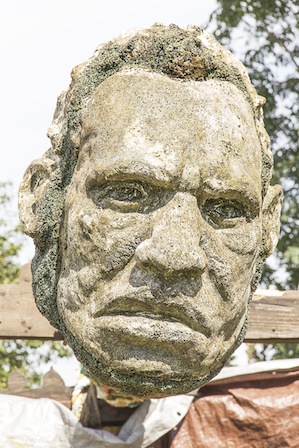ALAN CAPPER
“We believe in taking risks with what we show. We also have to counter the negative feelings about art today by providing openness and access to stimulating work,” says John Hatfield, executive director of Long Island City’s Socrates Sculpture Park.
He was standing in the center of the park two days before the opening of the new show, EAF13, emerging artists and fellows, with 15 new pieces being shown.
The park is looking very attractive, even with artists and workers putting the final touches on their work. This once barren piece of landscape has become a real mixed art center under Hatfield’s leadership. During this time the park has staged yoga and Tai Chi, a series of foreign films in conjunction with Manhattan’s Film Forum, Little Bastille Day and Opera and Shakespeare on the Waterfront, all of which have boosted the garden’s attendance and enhanced its reputation.
“It certainly was a barren place,” says Hatfield. ”Although it is in a spectacular position at the confluence of the Harlem and East Rivers, this four-and-a-half acre site was used as a landfill and illegal dumping site, with no trees at all.”
Interestingly, the area had one asset that linked it to sculpture and that was good quality of stone. That was one of the things that persuaded Noguchi to set up his studio there.
Hatfield is justifiably proud of the remarkable coalition of the artists and community leaders under the leadership of sculptor Mark Di Suvero, who had the vision and tenacity to persuade the city to allow it to be turned into a sculpture park. He believes that alongside the Noguchi Museum and the Sculpture Center, Long Island City has become the sculpture center of the city.
He is himself a sculptor, although these days it is for private pleasure only.
“I no longer have the pressure of having to sell my work,” he says. “I am a facilitator and I have two curators who initially select the work, and I do not always like what has been chosen. I have a simple method of evaluating an artist’s work — should this be seen, and what does it communicate?”
He believes that his background more than prepared him to face the challenges and opportunities he must now deal with. He describes himself as an “army brat,” having seen a great deal of the country through his father’s travels and postings.
He was always attracted to sculpture, and eventually spent 17 years at the New Museum of Contemporary Art in Manhattan, eventually becoming its deputy director.
With his sensitivity to the anxieties and needs of the artists and the skills he has acquired in strategic planning and management, he has an excellent combination of abilities to manage the park, which does not charge admission fees, is open 365 days a year and is in constant need of donations for its survival and future growth.
“What I love about this park is its space, its openness, and particular moments of rare beauty, for example when the light changes, or it begins to rain. It is a perfect place to show sculpture and to encourage connection with art in its broadest sense and in the specific. One of the things I am most proud of is the free education we provide for 8,000 children, and grown ups too. I say ‘come here, see enjoy, admire, dislike’ make art part of the fabric of your life.”
Hatfield is a man who considers art at two levels, the first the management and success of the Socrates Sculpture Park.
“We take risks, but the greater risks are taken by the artists themselves when they finally expose their work to the public.”
The second is another passion.
“We have to break the cycle of how art is being displaced in our lives,” he says.
RECOMMENDED STORIES









































